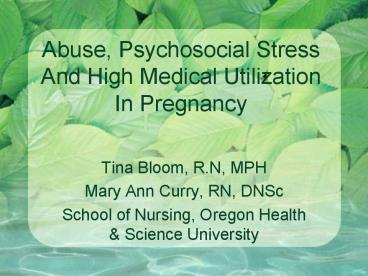Abuse, Psychosocial Stress And High Medical Utilization In Pregnancy - PowerPoint PPT Presentation
1 / 19
Title:
Abuse, Psychosocial Stress And High Medical Utilization In Pregnancy
Description:
A secondary analysis from 'Randomized Nursing Intervention to Abused Pregnant Women' (2001-2005) ... Pregnant women who used more medical services in our study ... – PowerPoint PPT presentation
Number of Views:262
Avg rating:3.0/5.0
Title: Abuse, Psychosocial Stress And High Medical Utilization In Pregnancy
1
Abuse, Psychosocial Stress And High Medical
Utilization In Pregnancy
- Tina Bloom, R.N, MPH
- Mary Ann Curry, RN, DNSc
- School of Nursing, Oregon Health Science
University
2
A secondary analysis from Randomized Nursing
Intervention to Abused Pregnant Women
(2001-2005).
- RO1 NR02696, National Institutes of Nursing
Research. - Dr. Mary Ann Curry, P.I.
3
General High Utilization
- Half of ED visits for non-urgent reasons
- Most emergency department patients do not require
hospitalization - Serial users account for many ED visits
(Cook et al, 2004 Mandelberg, Kuhn, Kohn,
2000)
4
Characteristics of High Utilizers in General
Literature
- Multiple complaints sprains, superficial
injuries, back problems, headaches, or abdominal
pain - Chronically ill
- Male or female
5
Characteristics of High Utilizers in General
Literature
- Non-white
- Stressed, isolated, mentally ill, ETOH abusers
- Uninsured, underinsured, low income
- Abuse, trauma (current or historical)
(Cook et al, 2004 Mandelberg, Kuhn, Kohn,
2000)
6
Trauma and High Utilization
- Childhood trauma/sexual abuse history and IPV
associated with physical and mental health
sequelae, and - High utilization of medical services
- IPV in pregnancy 0.9 to 20.2
Hendricks-Matthews, 1992 Arnow, 2004 Arnow et
al 2000 Campbell 2002 Farley Patsalides,
2001 Katon, Sullivan, Walker, 2001 Rosenberg
et al., 2000 Stein et al., 2000, 2004 Katon et
al., 2001 Gazmararian et al 2000.
7
Utilization in Pregnancy
- Most utilization
- literature focuses on
- women with little or no
- prenatal care, and/or
- late entry to prenatal
- care.
8
Research Question
- Do psychosocial stressors (trauma, abuse) and
social disadvantage (poverty, race, lack of
resources) play a significant role in high
medical utilization among pregnant women?
9
Randomized Nursing Intervention to Abused
Pregnant Women Study
- A multi-site RCT to determine if a nurse-case
management intervention have a significant impact
on pregnancy outcomes, including medical
utilization, for women at risk for or
experiencing violence?
Curry et al (2006). Nurse case management for
pregnant women experiencing or at risk for abuse,
JOGNN, 35, 181-192 .
10
Secondary Analysis 500 Pregnant Women
- Members of a West Coast HMO.
- 68 Caucasian
- 16 African American
- Latino 4
- Asian/Pacific Islander 4
- Native American/Alaskan Native 1
11
Secondary Analysis 500 Pregnant Women
- Mean age 29.72 (5.91)
- Mean income 3871 (2889)
- Mean education 15 yrs (2.86)
- 68 married
- 17 single, living with partner
12
High Utilizers (HU) in This Study
- Women with 5 or more visits to the LD, urgent
care, ED, or nurse treatment (2SD mean) - HU n41 mean of visits 7.78 (3.2)
- LU n328 mean of visits 0.99 (1.1)
13
Recent Abuse
p 14
High Utilizers Differed Significantly from Low
Utilizers, p
- Uninsured or Oregon Health Plan
- Non-white
- Lower income
- High school dropouts
- Younger
15
Diagnoses for High Utilizers
- Preterm onset of contractions/PTL
- Hyperemesis
- Gestational Diabetes
- Weight disorders
- Neurological problems
- Musculoskeletal problems
p
16
No Significant Differences
- Gravida/Parity
- Previous complications
- Onset of prenatal care
- Maternal or infant hospital stay at delivery
- Birth weight (145 g. difference--ns)
Gestational age at delivery did differby 4.4
days HU38.48 weeks, SD 1.6 LU39.12, SD
1.9,. p
17
Conclusion
- Pregnant women who used more medical services in
our study were a vulnerable group characterized
by past and current violence, economic
disadvantage, psychosocial stress.
18
Limitations
- Broad categories for diagnoses and chief
complaints - Small number of participants esp. for HU
- Did not measure emotional abuse or mental health
symptoms in this study
19
Implications
- High utilizers are a vulnerable group that are
more likely to be in need of social services,
extra support due to high stress, low self
esteem, abuse - We could have predicted high utilization _at_ T1
(weeks 16-23). This is a missed opportunity to
provide needed services. - Need for more research. Urgent care clinic or
hospital a refuge?































